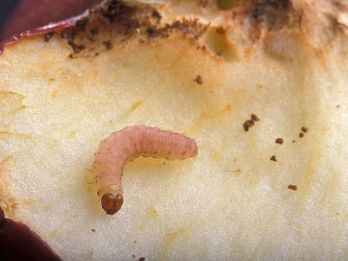Codling moth
Codling moths (Cydia pomonella) are a pest species threatening agricultural and horticulture industries.
Background
Codling moths are present in Australia, and have spread across Europe, Asia, Africa, North and South America, and islands in the Pacific.
These moths mainly target apples, pears, quinces, and stone fruit. They breed when the average temperature is over 15 degrees in spring and early summer.
Impacts
Because the larvae don't feed on leaves, their fruit consumption can damage almost an entire orchard crop if not controlled. This fruit is unmarketable and can contaminate other fruit when stored together, causing rot.
Fruit damage is easily visible in apples as a small brown hole, with brown frass (caterpillar poo) exuding from it. Cutting the fruit in half will reveal a tunnel through to the core where the caterpillar is feeding.
Management
Management
Follow these steps to help control the lifecycle of codling moths:
- Inspect your trees for:
- chewed leaves
- young caterpillars
- holes in young fruit.
- Remove and burn contaminated or fallen fruit, or feed it to appropriate animals (e.g. chickens).
- Remove caterpillar habitats such as loose bark and dead leaf build up in the branches and forks of trees.
Tree banding
Codling moth bands are a cultural control method which is most effective in spring, but the bands can be used year-round.
- Wrap corrugated cardboard around the trunk and large branches in bands to give caterpillars a place to pupate.
- Every 3 weeks, take off the bands and burn them.
Paling traps
Fence paling is a simple organic method that has been used in orchards for decades.
- Screw together 2 pieces of 30cm fence paling, with a 5mm gap in between. The codling moth larvae use the gap as a place to pupate.
- Suspend the traps in trees in the orchard.
- Every 3 weeks, remove them to destroy the pupating moth larvae.
Bait traps
Homemade and commercial trapping stations use sweet substances like molasses, fermented apple juice, or diluted port. These baits attract coddling moths which can't escape from the liquid or sticky surface.
- Cut a hole in the side of a plastic milk bottle.
- Fill the bottom with 5cm of molasses mixture and add a layer of vegetable oil.
- Suspend the traps from every third tree in the garden and monitor to find out how the population is increasing or decreasing in your garden.
Glues and sticky banding
Apply horticultural glue in a band around the tree trunk to trap female adult moths entering to lay eggs in spring.
Chemical control
Pyrethrum sprays will control adult moths but may also harm beneficial insects.
Eco Oils can be used to suffocate moth eggs when you first see them. Application rates vary but a consistent regimen of re-spraying is necessary to:
- control new eggs
- compensate for rain washing the oil off the leaf surfaces.
Identification
The adult codling moth is grey, about 10mm long with a 20mm wingspan.
It has a copper-coloured patch on each wing tip and brown banding along the upper surface of the wing. The hind wings of the moth are usually fringed.
Lifecycle
Female codling moths lays about 60 whitish grey eggs that are the size of a pinhead. These are found on the surface of fruit tree leaves and hatch after 10 days.
The caterpillars feed on the leaf surface near the midrib, forming a gallery in the leaf, before burrowing into fruit. They spend 3 to 5 weeks feeding and growing inside the fruit near the core.
When they emerge, codling moth caterpillars are yellow-red to white-pink in colour and about 20mm long. They look for a tight space to form cocoons and pupate, such as:
- loose bark or crevices on the tree
- pruned branches below the tree
- fences or tree supports
- in the ground.
The pupae are light brown in a white mesh cocoon. They become moths after 18 to 30 days during summer and repeat the cycle twice more in the season.
The final generation of the season delays its emergence as adults, overwintering and emerging in the next spring to start the cycle again.


